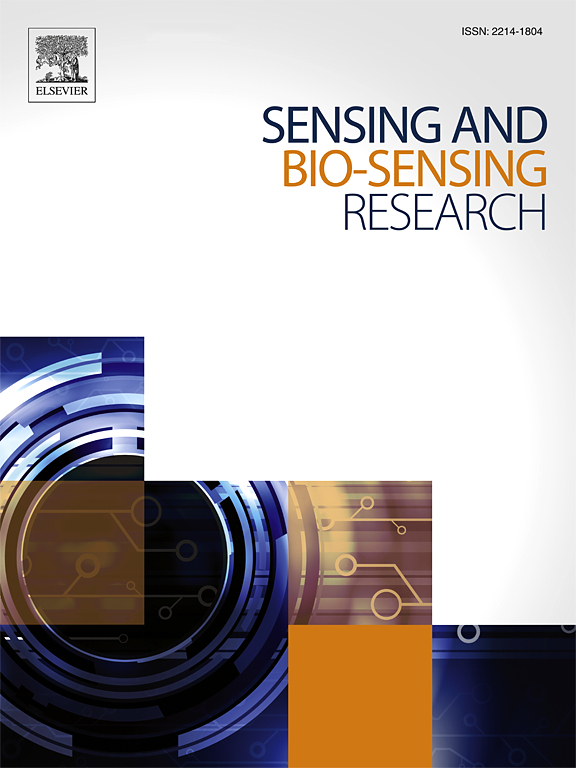基于肽金属框架的电化学传感器检测17- β雌二醇:异位妊娠诊断的潜在候选物
IF 4.9
Q1 CHEMISTRY, ANALYTICAL
引用次数: 0
摘要
女性性特征的发育和维持依赖于它。最近的研究表明E2水平降低与异位妊娠的概率显著升高相关。E2水平≤100 pg/mL的孕妇更容易发生异位妊娠。因此,本研究旨在开发一种电化学传感器,用于检测17 β雌二醇,作为识别异位妊娠的潜在生物标志物。简而言之,以谷胱甘肽铜配合物作为氧化还原介质进行E2传感。采用简单的室温一锅法合成了谷胱甘肽铜配合物,并用紫外可见光谱和红外光谱对其进行了表征。然后用扫描电镜(SEM)分析了谷胱甘肽铜配合物的形貌。由此提出谷胱甘肽铜配合物的M:L比为1:2。然后,利用循环伏安法和差分脉冲伏安法等电化学技术对E2进行检测。结果表明,E2浓度增加,峰值电流逐渐减小,呈较强的线性负相关。反比关系表明E2在铜与谷胱甘肽配合物的作用下在电极表面被氧化。根据我们的研究结果,PBS和人工尿液样本中E2的LOD分别为0.125 pg/ml和4.99 pg/ml。PBS和人工尿液中E2的定量限分别为5884 pg/ml和8969 pg/ml。我们开发的工作电极对异位妊娠诊断中酪氨酸(Y)和色氨酸(W)和铅没有任何干扰。本文章由计算机程序翻译,如有差异,请以英文原文为准。
Peptido-metal framework based electrochemical sensor for the detection of 17- β estradiol: A potential candidate for the diagnosis of ectopic pregnancy
The development and maintenance of female sexual features depend on it. Recent investigations indicate that reduced E2 levels are correlated with markedly elevated probabilities of ectopic pregnancy. Those with E2 levels ≤100 pg/mL were more likely to experience ectopic pregnancy. So, the present work aims to develop an electrochemical sensor for detecting 17 β estradiol as a potential biomarker for identifying ectopic pregnancy. In brief, the E2 sensing were carried out using glutathione copper complex as redox mediator. The glutathione copper complex has been synthesized using simple room temperature one pot procedure and characterized using UV Visible spectroscopy, FTIR for confirming coordination. Then the morphology of glutathione copper complex was analysed using Scanning electron microscopy (SEM). From that the glutathione copper complex proposed the M:L ratio is 1:2. Then, the sensing of E2 were carried out using different electrochemical techniques, including Cyclic voltammetry and Differential Pulse Voltammetry. Our results indicated that the concentrations of E2 increases, peak current gradually decreases with the strong linear negative correlation. The inverse relationship indicates that E2 is being oxidized at the electrode surface with the help of copper complex with glutathione. Based on our findings, the LOD for E2 in PBS and artificial urine sample was found to be 0.125 pg/ml and 4.99 pg/ml respectively. Whereas LOQ for E2 in PBS and artificial urine sample was found to be 5884 pg/ml and 8969 pg/ml respectively. Our developed working electrode does not show any interference with Tyrosine(Y) and Tryptophan(W) and lead for ectopic pregnancy diagnosis.
求助全文
通过发布文献求助,成功后即可免费获取论文全文。
去求助
来源期刊

Sensing and Bio-Sensing Research
Engineering-Electrical and Electronic Engineering
CiteScore
10.70
自引率
3.80%
发文量
68
审稿时长
87 days
期刊介绍:
Sensing and Bio-Sensing Research is an open access journal dedicated to the research, design, development, and application of bio-sensing and sensing technologies. The editors will accept research papers, reviews, field trials, and validation studies that are of significant relevance. These submissions should describe new concepts, enhance understanding of the field, or offer insights into the practical application, manufacturing, and commercialization of bio-sensing and sensing technologies.
The journal covers a wide range of topics, including sensing principles and mechanisms, new materials development for transducers and recognition components, fabrication technology, and various types of sensors such as optical, electrochemical, mass-sensitive, gas, biosensors, and more. It also includes environmental, process control, and biomedical applications, signal processing, chemometrics, optoelectronic, mechanical, thermal, and magnetic sensors, as well as interface electronics. Additionally, it covers sensor systems and applications, µTAS (Micro Total Analysis Systems), development of solid-state devices for transducing physical signals, and analytical devices incorporating biological materials.
 求助内容:
求助内容: 应助结果提醒方式:
应助结果提醒方式:


